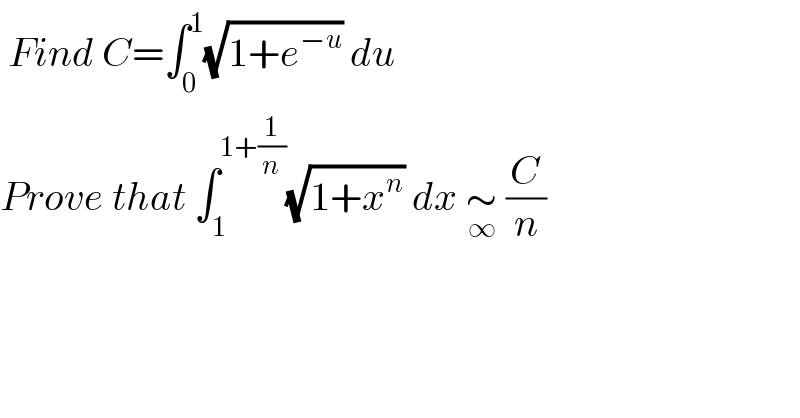
Question and Answers Forum
Question Number 125737 by snipers237 last updated on 13/Dec/20

Answered by MJS_new last updated on 13/Dec/20
![∫(√(1+e^(−u) ))du= [v=(√(1+e^(−u) )) → du=2(v/(1−v^2 ))dv] =∫(v^2 /(1−v^2 ))dv=∫(−2+(1/(v+1))−(1/(v−1)))dv= =−2v+ln ∣((v+1)/(v−1))∣ =... =−2(√(1+e^(−u) ))+2ln ((√e^u )+(√(1+e^u ))) +C now insert borders](Q125747.png)
Answered by mathmax by abdo last updated on 13/Dec/20
![C =∫_0 ^1 (√(1+e^(−u) )) du changement (√(1+e^(−u) ))=t give 1+e^(−u) =t^2 ⇒ e^(−u) =t^2 −1 ⇒−u =ln(t^2 −1) ⇒u=−ln(t^2 −1) ⇒(du/dt)=−((2t)/(t^2 −1)) ⇒ C =−2∫_(√2) ^(√(1+e^(−1) )) (t^2 /(t^2 −1))dt =2 ∫_(√(1+e^(−1) )) ^(√2) ((t^2 −1+1)/(t^2 −1))dt =2((√2)−(√(1+e^(−1) ))) +∫_(√(1+e^(−1) )) ^(√2) ((1/(t−1))−(1/(t+1)))dt =2(√2)−2(√(1+e^(−1) )) +[ln∣((t−1)/(t+1))∣]_(√(1+e^(−1) )) ^(√2) =2(√2)−2(√(1+e^(−1) )) +ln((((√2)−1)/( (√2)+1)))−ln((((√(1+e^(−1) ))−1)/( (√(1+e^(−1) ))+1)))](Q125787.png)
Answered by mathmax by abdo last updated on 13/Dec/20
![A_n =∫_1 ^(1+(1/n)) (√(1+x^n ))dx changement x=t+1 give A_n =∫_0 ^(1/n) (√(1+(t+1)^n ))dt but n→+∞ ⇒t→o and 1+(t+1)^n ∼1+nt ⇒A_n ∼ ∫_0 ^(1/n) (√(1+nt))dt changement (√(1+nt))=z give 1+nt =z^2 ⇒nt=z^2 −1 ⇒t =(1/n)(z^2 −1) ⇒ ∫_0 ^(1/n) (√(1+nt))dt =∫_1 ^(√2) z (1/n)(2z)dz =(2/n)∫_1 ^(√2) z^2 dz =(2/(3n))[z^3 ]_1 ^(√2) =(2/(3n))(2(√2)−1) ⇒ A_n ∼((4(√2)−1)/(3n)) we can take C =((4(√2)−1)/3)](Q125788.png)
Commented by mathmax by abdo last updated on 14/Dec/20
![sorry 1+(t+1)^n ∼2+nt ⇒A_n ∼∫_0 ^(1/n) (√(2+nt))dt we do the changement (√(2+nt))= u ⇒2+nt=u^2 ⇒nt=u^2 −2 ⇒t=(1/n)(u^2 −2) ⇒ ∫_0 ^(1/n) (√(2+nt))dt =∫_(√2) ^(√3) u×(2/n) u du =(2/n)∫_(√2) ^(√3) u^2 du =(2/(3n))[u^3 ]_(√2) ^(√3) =(2/(3n)){3(√3)−2(√2)} ⇒A_n ∼((6(√3)−4(√2))/(3n)) ⇒C=((6(√3)−4(√2))/3)](Q125810.png)
